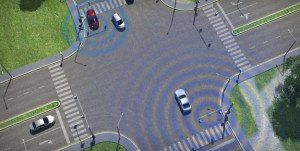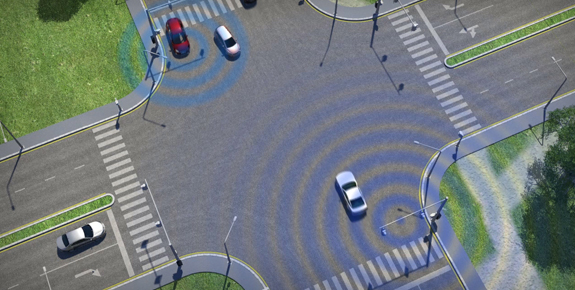The government should set performance standards for new safety technology that allows cars and trucks to talk to each other and then require the technology be installed in all new vehicles, a federal accident investigation board recommended Tuesday.
The National Transportation Safety Board made the recommendation in response to fatal school bus accidents at intersections in New Jersey and Florida last year.

Vehicles equipped with the technology can continuously communicate over wireless networks, exchanging information on location, direction and speed 10 times a second. The vehicle’s computer analyzes the information and issues danger warnings to drivers, often before they can see the other vehicle.
The technology is effective up to a range of about 1,000 feet. The National Highway Traffic Safety Administration has been road-testing the technology in Ann Arbor, Mich., for the past year. NHTSA officials have said they hope to make a decision on whether to proceed to setting standards or whether to continue their research by the end of this year.
“This technology more than anything else holds great promise to protect lives and prevent injuries,” NTSB Chairman Deborah Hersman said. That was particularly true of crashes at intersections like the two school bus accidents, she added.
But an auto industry official said the board was acting precipitously.
“The technology is still being assessed,” said Gloria Bergquist, vice president of the Alliance of Automobile Manufacturers. “It’s too early to call for a mandate.”
In the New Jersey accident in February 2012, a dump truck slammed into the rear left side of a school bus at an intersection near Chesterfield, spinning the bus around until it collided with a pole. An 11-year-old girl was killed and five other students were seriously injured.
The next month in Port St. Lucie, Fla., a semi tractor-trailer truck hit a school bus on a side toward the rear, spinning the bus around. One student was killed and four others were seriously injured.
The board was meeting to determine the probable cause of the New Jersey accident and to make safety recommendations. Findings from the previously concluded Florida accident investigation were also considered because of the similarities in the two crashes.
The New Jersey accident was caused by the school bus driver’s failure to note the oncoming dump truck when he pulled into the intersection, the board said. The bus driver had stopped part way into the intersection to get a better view of traffic coming from the left – the direction from which the dump truck was traveling – and should have been able to see the truck, investigators said.
Instead, the driver proceeded fully into the intersection. The board concluded that the bus driver experienced “inattention blindness” – he saw, but didn’t register that he was seeing, a truck coming, because he was suffering from fatigue and the sedating effects of several prescription medications.
The driver reported that he had only five hours of sleep for each of the preceding three nights, investigators said.
A little over a month before the accident, the driver’s medical certification allowing him to drive commercial vehicles had been renewed. But the renewal was based on an exam by a chiropractor instead of the driver’s regular physician, investigators said.
The driver didn’t disclose several of the prescription medications he was taking to the chiropractor, and the chiropractor wouldn’t have had enough training in the side effects of drugs to determine their impact on the driver’s fitness, investigators said.
It’s likely that if the driver had disclosed the medications, and if the medical examiner had better knowledge of prescription drugs, the driver’s medical certificate wouldn’t have been renewed and he would have been unable to legally drive commercial vehicles, investigators said.
In response, the board reiterated several recommendations – some dating back more than a decade – calling for the Federal Motor Carrier Safety Administration to develop a better system for ensuring that commercial bus and truck drivers receive thorough medical exams from qualified examiners.
The dump truck driver and the trucking company he worked for also contributed to the severity of the accident, the board said.
The truck was traveling between 53 mph to 58 mph in a 45 mph speed zone, investigators said. Also, a series of problems with the truck’s brakes reduced the effectiveness of the vehicle’s braking by 32 percent, they said. The 85,000-pound truck was also about 5,000 pounds overweight, making it harder to stop and the impact of the crash more severe.
The board called on regulators to require trucks used for hauling, like dump trucks and garbage trucks, to be equipped with onboard weight monitoring systems to alert drivers when vehicles are overweight. The board also repeated a previous recommendation that large trucks be required to have brake monitoring systems that alert drivers when brakes need to be serviced.
New Jersey and Florida are two of only six states that require new school buses to have seatbelts, and both buses were equipped with lap belts. But some students weren’t wearing their belts, contributing to the severity of injuries, the board said. Also, injuries would have been reduced if the seatbelts were shoulder harness and lap belts rather than just lap belts, investigators said.
Was this article valuable?
Here are more articles you may enjoy.


 New York Considers Making Property Insurers Cover Taxi Claims Losses
New York Considers Making Property Insurers Cover Taxi Claims Losses  Texas Accuses Allstate-Owned Arity of Data Privacy Violations
Texas Accuses Allstate-Owned Arity of Data Privacy Violations  Cargo Theft Surges as Holiday Season Approaches, Verisk Says
Cargo Theft Surges as Holiday Season Approaches, Verisk Says  AI Focal Point of Cybersecurity Outlook for 2025, Says Experian
AI Focal Point of Cybersecurity Outlook for 2025, Says Experian 